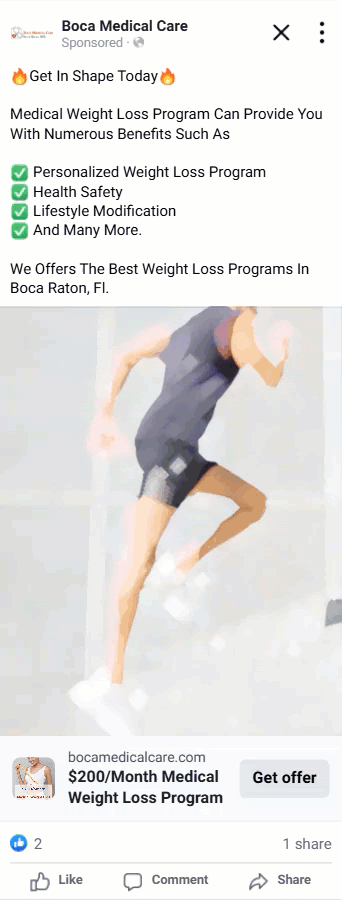Video Marketing For Doctors and Dentists is Recommended
Video marketing is one of the most effective ways for medical and dental practices to attract new patients, build trust, and engage existing ones. By creating educational videos, testimonials, promotional content, and virtual tours, you can enhance your digital presence, demystify procedures, and offer value to potential patients. With the rise of platforms like YouTube, Instagram, and Facebook, video content is an accessible, powerful tool for marketing your medical or dental practice. AI Based videos for healthcare practices is currently (2026) not recommended by PatientGain. However, this may change in the future.
Example of a video created to promote medical weight loss.

1. Welcome and Introduction Video
- Example 1: Dental Practice Introduction: A dentist’s office could introduce the practice’s services, team, and office environment, showcasing the atmosphere with friendly staff members. The video could explain the practice’s philosophy, such as a focus on patient comfort, modern technology, or a gentle approach for nervous patients.
- Example 2: Medical Spa Overview: A medical spa could create a video that introduces the team, highlights state-of-the-art equipment, and offers a tour of treatment rooms, promoting the spa’s welcoming and luxurious ambiance. This introduction can build a personal connection and make new patients feel at ease.
2. Patient Testimonials
- Example 1: Orthodontics Success Story: A patient shares their transformation through braces or Invisalign treatment, showing before-and-after images and explaining their positive experience at the clinic, focusing on how the practice made them feel comfortable throughout the process.
- Example 2: Cosmetic Dentistry Testimonial: A patient who underwent a smile makeover, including procedures like veneers or whitening, talks about the results, how it changed their confidence, and why they chose the dental practice for their procedure.
3. Educational and “How-To” Videos
- Example 1: Oral Hygiene Tips: A dental practice could create a “how-to” video demonstrating the correct brushing technique, the importance of using dental floss, or the best products for maintaining oral health. This helps patients learn simple yet effective oral care habits.
- Example 2: Skin Care Advice for Acne Treatment: A medical spa offering acne treatments could create a video explaining common causes of acne and how specific treatments (like chemical peels or laser therapy) can help reduce acne, along with aftercare tips.
4. Procedure or Treatment Explanation Videos
- Example 1: Root Canal Treatment: A dental practice explains what happens during a root canal procedure, what the patient can expect in terms of pain management and recovery, and why this procedure is essential for saving a tooth.
- Example 2: Botox Injection Process: A medical spa could showcase the Botox injection process, explaining how it works, the benefits, the procedure steps, and safety precautions, helping patients feel informed and confident in their decision.
5. Frequently Asked Questions (FAQ) Videos
- Example 1: Dental Visit FAQ: A dental clinic could answer common questions such as, “What should I expect during my first visit?” or “How often should I visit for a cleaning?” This video helps set patient expectations and reduces any apprehensions they may have.
- Example 2: Laser Hair Removal FAQ: A medical spa could create a video answering common laser hair removal questions, such as “Is the treatment painful?” or “How many sessions are needed for permanent hair removal?” These FAQs help demystify the process and encourage potential clients to book a consultation.
6. Promotional Videos
- Example 1: Special Discounts or Offers: A dental practice runs a Back-to-School Special where new patients receive a discount on their first cleaning. The promotional video highlights this limited-time offer, the benefits of regular dental visits, and how to book an appointment.
- Example 2: Seasonal Skin Care Promotions: A medical spa could promote a summer skincare special, offering discounts on services like facials or chemical peels. The video could show the importance of sun protection and skin care during summer, along with an exclusive offer.
7. Virtual Tour of the Facility
- Example 1: Dental Office Tour: A dental practice might offer a virtual tour that walks viewers through the waiting area, treatment rooms, and sterilization area. This gives patients a look at the practice’s cleanliness, state-of-the-art equipment, and overall welcoming atmosphere.
- Example 2: Medical Spa Facility Tour: A medical spa could showcase its treatment rooms, relaxation spaces, and luxury amenities. Highlighting the calming ambiance, comfortable surroundings, and attention to patient comfort can make potential clients feel more at ease before their visit.
8. Testimonial Collection Through Video
- Example 1: Smile Transformation Video: A patient who received cosmetic dental work, like veneers or whitening, discusses their experience, shows before-and-after photos, and shares how the treatment impacted their self-esteem and daily life.
- Example 2: Medical Spa Treatment Feedback: A patient shares their journey of receiving a facial treatment or body contouring procedure at the medical spa. They explain the results and how it positively impacted their confidence and overall well-being.
9. Social Media and Behind-the-Scenes Content
- Example 1: Dental Practice Social Proof: A dentist could share a short video of a procedure, such as teeth whitening, with quick clips of the treatment process, and then end with patient reactions to their newly brightened smile, which is perfect for social media.
- Example 2: Medical Spa Behind-the-Scenes: A medical spa could offer a behind-the-scenes look at how their treatments work. This could include clips from a consultation, the preparation of equipment, and the application of a treatment like Botox or microneedling, showcasing professionalism and care.
10. Video Challenges or Campaigns
- Example 1: Dental Health Challenge: A dentist could run a fun social media campaign where followers post their daily brushing routines, using a branded hashtag. The video campaign could highlight the benefits of proper brushing and promote the practice.
- Example 2: Skin Care Challenge: A medical spa could launch a 30-day skin care challenge, where followers are encouraged to try a specific product or service. Participants can share their experiences through video, with the spa showcasing patient progress in the final campaign video.
Conclusion
Video marketing is an invaluable tool for medical and dental practices to educate, engage, and build trust with both new and existing patients. By creating engaging videos like patient testimonials, procedure explanations, educational content, and promotions, practices can effectively showcase their expertise, build social proof, and increase patient conversion rates. With the rise of social media and video-sharing platforms, video is now one of the most effective ways to connect with and attract potential patients.
Examples of effective videos for doctors and dentists include:
1. Before & After Videos
2. Customer Testimonials (see a very successful example)
3. Product Demonstrations
4. Company Spokespeople
An area that many medical practices are not fully embracing is video marketing. National healthcare brands or even local brands associated with a major health system or a university may spend tens of thousands of dollars on a video for advertising purposes. As the owner of a single medical practice, it is unlikely you have that sort of money to hire a professional to film and edit a video. However, you do not have to put together a great video to advertise your medical practice.


Direct to consumer video marketing cuts out the middleman of a video production crew and allows you to speak directly to your patients and potential new patients. With that in mind, you do need to put some time and effort into crafting a great video. Filming it with a shaky cell phone is not going to cut it. You want your video to be a few notches better in terms of the quality of a Snapchat video or something you would post on Instagram. You also want to make sure your video catches the eye of your target audience and does not get lost in the sea of other video content out there.
1. Use Humor To Education and Keep Your Audience’s Attention
Video marketing has several themes that are often used by businesses. These themes are usually:
1. Before & After Videos
2. Customer Testimonials
3. Product Demonstrations
4. Company Spokespeople
While these videos are usually educational, they are a dime a dozen. Your goal is to educate and to stand out amongst your competitors. A way many brands, especially new companies and brands taking on nationally well-known competitors, are standing out is using humor.
Why is humor so effective? It is playing into the reason why many people go online to watch videos: to be entertained or to learn something. A video that is not only entertaining but educational is a very effective communication tool. For some brands, it is very easy to weave humor into talking about their products or services. As a medical practice, you need to be mindful that your humor is appropriate for your target audience. You likely cannot be as edgy as some of the other videos out there, but you should feel free to poke fun at yourself or your staff. A good rule of thumb is to “punch up” and not “punch down” with your humor.
2. Convert Viewers Into Customers
Storytelling is very popular in healthcare marketing. Stories from real people talking about how they feel better after receiving medical are very powerful. It is one thing to read in a pamphlet about your treatments and services; it’s a whole other world to hear from someone who has benefited from it. Storytelling marketing videos is a great way to market your medical practice to a target audience when you have someone fitting that target audience telling their story about their treatment.
These marketing videos can be challenging to produce. You need to find someone who is willing to talk about their experience and ready to have it shared with everyone. Not every medical issue is something that a patient will want to share. It may be easier to get someone to talk about getting stitches due to an accidental cut on Christmas Eve than it is to have someone talk about STD testing. Some patients may also demand compensation to have their stories recorded and told.
3. Test Which Videos Connect Most With Your Viewers
It may, at first, be difficult to determine which videos connect most with your patients and the community. It is best to test out different video themes, subjects, and settings to find the combination that garners the most engagement and views. In order to gauge the success of a video format, be sure to establish some measurable goals. Some metrics that can be track include:
- Views
- Shares
- Comments
If possible, try to have your staff keep track if people mention the video to them. This will be more anecdotal, but it can still be an essential metric to track to help you make a decision on which videos are more helpful to film.
Some variables you can experiment with include:
- Video length
- Scripted vs. improvised
- Who appears in your video
- Q & A vs. Testimonials
4. Put Effort Into The Quality Of Your Video
Today’s technology makes it easy for someone to film a video. But not every video is worth putting online. Ensure that you establish some quality control to make sure any video you put out there is as best it can be for your target audience. There are a few things to consider when filming a video for your marketing purposes.
For videos where you have time to sit down and edit them, use a camera mounted to a try pod. Handheld footage can be shaky and turn off viewers. You are not filming a high budget action sequence, so it is unlikely you are going to need to move a camera to follow someone during a filming sequence. A tripod allows you to film a steady shot without worrying about accidentally cutting someone out of the frame.
Consider investing in audio and lighting upgrades to push the quality of your video. While a built-in microphone does an okay job at recording audio, a microphone, shotgun mic, or a wireless lavalier mic will do wonders to increase the quality of your video. No one wants to listen to a video where it is hard to hear the person talking or if there is a hum in the background. Lighting is also a vital feature of a good video. A few professional lights can really present a higher quality picture where you are filming. Avoid any light source in the background of what you are shooting as that can cause significant issues with the overall filming if you choose to film outside, avoid filming at different times of day that will be edited into a single video. The changes in sunlight will be very noticeable.
As a doctor or owner of a medical practice, it is unlikely you have a lot of experience with lighting, audio, and filming in general. Do yourself a favor and experiment with the equipment on your own and do a few test runs. These dry runs will allow you to work out any kinks in the process so that you don’t waste anyone’s time when filming begins.
Video marketing is a powerful tool for medical practices to engage and educate their patients. Direct to consumer-style videos can have a significant impact on your target audience, despite their relatively low budget. If done correctly, people can appreciate the scrappiness of these videos, and you may be able to convert them into loyal patients.
PatientGain currently (2026) does not recommend the use of AI-based videos for patient-facing healthcare marketing due to significant concerns surrounding patient trust, data security, potential for misinformation, lack of human empathy, and legal liability.
PatientGain perspective, while AI is a powerful tool for certain tasks like data analysis and back-end office operations, its application in direct patient communication, especially through video content, presents several critical drawbacks:
- Lack of Human Empathy and Connection: A core issue is that AI cannot replicate the empathy, compassion, and personal touch of a human healthcare provider, which are essential for building a strong, trusting patient-doctor relationship. Professional, human-created videos featuring actual staff and doctors are recommended instead to humanize the practice’s brand.
- Potential for Misinformation and Bias: AI models are trained on existing internet data, which can contain inaccuracies, biases, and outdated information. Using AI to generate medical advice via video risks spreading misinformation, which could directly harm patients and destroy a practice’s credibility.
- Data Security and Privacy Risks: The use of AI in healthcare involves managing massive amounts of sensitive patient data, raising significant privacy concerns. There are risks of data breaches, hacking, and the potential for patient information to be used for non-health purposes without explicit consent, which is a major concern for patients and a violation of regulations like HIPAA.
- Absence of Oversight and Accountability: A major legal and ethical grey area is determining accountability when an AI tool makes a mistake that results in patient harm. It is currently unclear whether the doctor, the hospital, or the software vendor would be at fault, making medical professionals hesitant to rely heavily on autonomous AI systems.
- Patient Apprehension: Patients themselves have expressed concerns about the safety and reliability of AI in their medical care, preferring that clinicians retain final discretion over treatment plans. Blindly trusting AI-generated content can erode patient confidence in the healthcare system as a whole.
